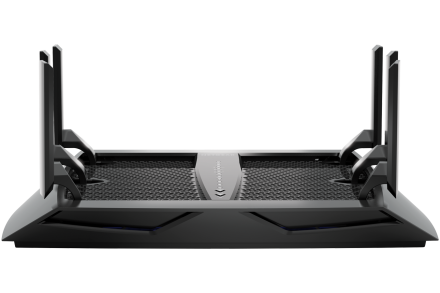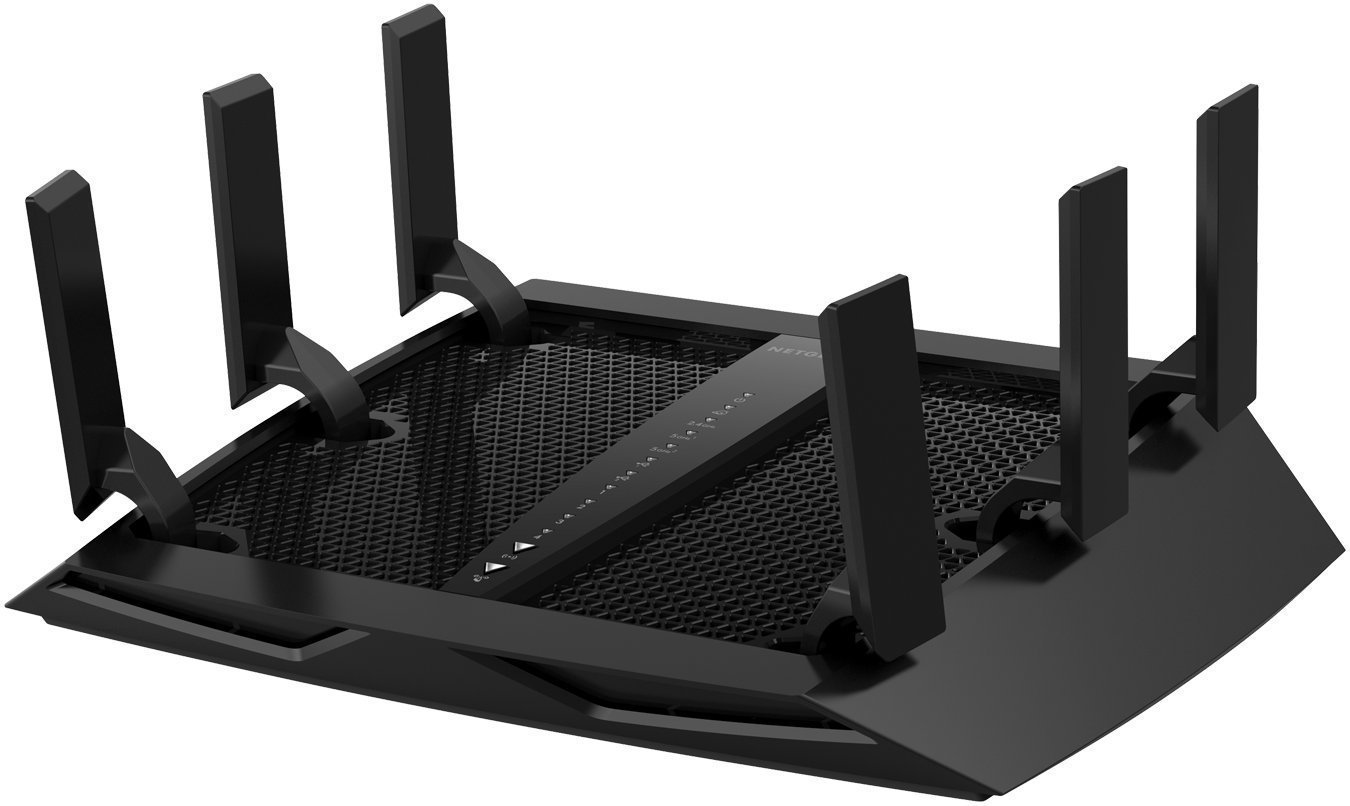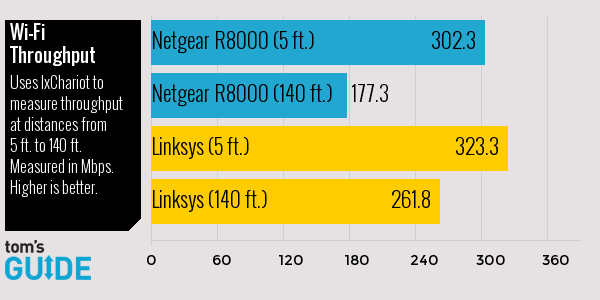Tom's Guide Verdict
A versatile tri-band design, easy setup and long range make Netgear's R8000 a strong router for a house filled with data hogs.
Pros
- +
Tri-band operations, good performance
- +
Genie software makes setup easy
- +
USB 2.0 and 3.0 ports
- +
Six fold-out antennas
- +
Excellent range
Cons
- -
Expensive
- -
Big design
- -
Lacks e-SATA port
- -
Not as fast as other tri-band routers
Why you can trust Tom's Guide
Editor's Note: As of Dec. 19, 2016, Netgear has issued security updates to patch a serious vulnerability in its routers, including the Nighthawk X6 AC3200. We recommend not using the router until its update is applied, so click here to find out how to install the patch.
If you thought three or four antennas would help boost 802.11ac wireless networking performance, Netgear's Nighthawk X6 AC3200 router has six and makes the most of them with excellent range. At $300, this is one of the most expensive routers on the market, but worth it if you want wireless data everywhere.
Design
Also known as the R8000, Netgear's all-black router's design is sharply angular with a geometrically patterned grille that makes it look like a spaceship. At 11.5 x 8.8 x 2.2 inches, the R8000 is one of the biggest Wi-Fi routers around, and unlike many of its peers, it needs to be set up horizontally or screwed into a wall.

Down the middle of the router's top there are no fewer than 13 LEDs that show which bands and ports are active, and whether it's turned on and has an Internet connection. It can look like a Christmas tree, but there's a switch in the back to turn all the lights off. You can also restart the R8000 with a handy on/off switch.

Able to handle three independent lanes of Wi-Fi data traffic, the R8000 has a single 2.4-GHz channel as well as a pair of 5-GHz channels, one of which can be reserved for high-speed traffic. The router's six rectangular antennas use beam-forming techniques to sculpt the signal to suit the receiving antenna.
MORE: Router Reviews
Rather than stubby cylindrical antennas, the R8000's fold out, extend up to 3.3-inches and can be adjusted up to a 140-degree angle. Unfortunately, unlike the Linksys WRT 1900AC, the R8000's antennas can't be replaced.
Setup
Using Netgear's Genie software, the R8000's setup wizard takes about 5 minutes to configure the router. After plugging it into your broadband modem and turning the R8000 on, open a browser window set to "routerlogin.net" and the router detects the type of connection you have and sets up just about everything for you.
Instead of an insecure generic network name and passcode, each R8000 has a unique network name and code programmed into it. That way, the router can be used right away, although you should change these items to be on the safe side.
Features
If you feel up to it, the R8000 can be manually configured. The router can also be set up as an access point, and the firmware allows you to enter everything from IP V.6 details to Maximum Transmission Unit (MTU) size. Talk about customizable. Each of the router’s three operational bands can have its own network name, security setting and top speed.

The R8000 connected on the first try with a variety of devices, from desktops and tablets to phones, printers and an Internet radio. You can either enter the passcode manually or use the router's Wi-Fi Protected Setup (WPS) protocol.
In addition to the expected quartet of gigabit Ethernet ports for wired connections, the R8000 has USB 2.0 and 3.0 ports that can work with a printer and an external hard drive. I prefer the faster e-SATA connection that's on the Linksys WRT 1900AC. However, I do like that the drives connected to the Netgear router support Apple's Time Machine for networkwide backups. The router will also create a personalized URL for gaining remote access to the drive's contents.
The R8000 has up-to-date security that can protect the network. In addition to being able to block specific clients and sites, the R8000 uses the latest security protocols, right up to WPA2/Enterprise encryption. It supports using a Virtual Private Network (VPN) as well as including both Stateful Packet Inspection (SPI) and Network Address Translation (NAT) firewalls. While the router has a Guest network that can allow Web browsing while blocking access to network drives, it doesn't use industrial-strength LDAP client authentication for an added level of security.
MORE: Best All-in-One PCs
Genie Software
In addition to getting the router up and running, Netgear's Genie software can show you what's up and adjust the network's settings; there's desktop and mobile versions for Android and iOS devices, too. The apps show a nice dashboard that includes the number of connected devices, information about the network and the firmware version in use.

On top of parental controls, you can view a list or map of connected clients. Genie has a Traffic Meter, which shows upload and download speeds as well as local activity. You can also see which Wi-Fi channels are being used as well as differentiate between yours and your neighbors. Genie can send you an email when a new client logs on.
Performance
Inside the R8000 is a 1-GHz processor along with 256MB of RAM and 128MB of flash storage space for firmware, passwords and settings. The router never got more than warm to the touch and doesn't need the annoying cooling fan on the WRT 1900AC.
The beauty of a tri-band router is that you can manually apportion bandwidth among its channels, keeping older devices from slowing down newer ones. The R8000's Smart Connect feature will do it automatically, but you'll need to give both 5GHz channels the same network name.
The R8000 has a theoretical maximum throughput of 3.2 Gbps. In real-world testing using ixia’s ixChariot software, the R8000's two 5-GHz and one 2.4GHz channels added up to a peak total throughput of 702.4 Mbps 5 feet from the router. That's good, but 5 percent slower than the combined output of the Linksys WRT 1900AC tri-band router (732.3 Mbps).
At a distance of five feet on 802.11ac, the R8000 was able to deliver 302.3Mbps of bandwidth, well off the Asus RT-AC68U’s 361.3Mbps as well as the 323 Mbps of the Linksys WRT1900AC.

At 140 feet, the R8000's throughput of 177.3 Mbps on 802.11ac was again slower than the ASUS (291.7 Mbps) and the Linksys (261.8 Mbps).
In 802.11n mode, the R8000 was able to move 182.1Mbps at 5 feet, faster than the D-Link DG-5500 (179.9 Mbps), but slower than the class-leading Asus RT-N66U (216.5 Mbps).

However, the R8000 blew the others away in 2.4-GHz testing with a throughput of 97.8 Mbps at 5 feet, compared with 74.7 Mbps for the Asus RT-AC68U. In an older building, it had an exceptional range of 165 feet, 15 feet longer than Trendnet's TEW-812DRU router
A dependable performer, the R8000 passed our saturation test where we play a Netflix movie on an Android tablet, watch a TV show on a Windows PC and listen to an Internet radio, all while swapping data with a networked drive. There was more than enough throughout left over for a Hearhtstone gaming session.
Warranty
The R8000 includes only a 1-year warranty that's one-third as long as the coverage for the Trendnet TEW 812-DRU.
Bottom Line
At $300, the Netgear R8000 router is one of the most expensive routers in its class. And, while it doesn't provide the fastest overall speeds, it can securely blanket a home in data. Among other 802.11ac routers, the $249 Linksys WRT1900 and $220 ASUS RT-AC68U offer faster throughput for less money. Still, if you're looking for maximum range, the Netgear Nighthawk X6 AC3200 (R8000) won't disappoint.
Size: 2.2- x 11.7- x 8.9-inches
Number of Antennas/Removable: 6/No
Wifi Spec: Tri-band 802.11ac
Ports: 4 gigabit Ethernet, USB 2.0, USB 3.0
Peak 802.11ac performance: 702.4 Mbps
Range in 2.4GHz: 165
Follow us @tomsguide, on Facebook and on Google+.
Brian Nadel is a freelance writer and editor who specializes in technology reporting and reviewing. He works out of the suburban New York City area and has covered topics from nuclear power plants and Wi-Fi routers to cars and tablets. The former editor-in-chief of Mobile Computing and Communications, Nadel is the recipient of the TransPacific Writing Award.
-
Mexamilian Netgear R8000, ~15 feet away @ 866.5mbps on 5Ghz thru 2 walls and a door. review was not optimizedReply

